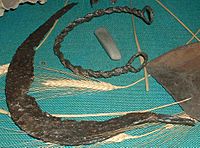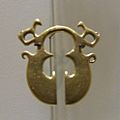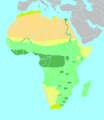Iron Age facts for kids
The Iron Age is the period after the Bronze Age. Iron production took place in Anatolia at least as early as 1200 BC, with some evidence pointing to even earlier dates. It is the final epoch of the three-age system, preceded by the Stone Age (Neolithic) and the Bronze Age.
As its name suggests, Iron Age technology is characterized by the production of tools and weaponry by ferrous metallurgy (ironworking), more specifically from carbon steel.
In the Mesopotamian states of Sumer, Akkad and Assyria, the use of iron reaches far back, to perhaps to 3000 BC. One of the earliest smelted iron artifacts known was a dagger with an iron blade found in a Hattic tomb in Anatolia, dating from 2500 BC. The widespread use of iron weapons which replaced bronze weapons rapidly disseminated throughout the Near East (North Africa, southwest Asia) by the beginning of the 1st millennium BC.
Before this time, people used bronze or flint tools, and pottery. They farmed, and lived in communities. Most of Europe, Africa and Asia reached the Iron Age by 500 BC. In Europe, it is a period of prehistory, as Iron Age people did not write their history down.
Iron is easy to find, but hard to make into tools. It melts at a higher temperature than bronze. When blacksmiths learned how to make iron tools, they were able to make many of them. With more and better tools, people could do more. For example, more people could own a metal plough. They could farm their fields better and grow more crops. Some people invented coins to help buy and sell their crops and their iron tools.
Bronze weapons and armor were no match for those made of iron, so many peoples who did not have iron were conquered by those who did. Armour was rare in western Europe's Iron Age, but people used shields and helmets to keep safe in battles.
Images for kids
-
Maiden Castle, Dorset, England. More than 2,000 Iron Age hillforts are known in Britain.
-
Silla chest and neck armour from the National Museum of Korea in Seoul (3rd century CE)
-
Lingling-o earrings from Luzon, Philippines
See also
 In Spanish: Edad del Hierro para niños
In Spanish: Edad del Hierro para niños








